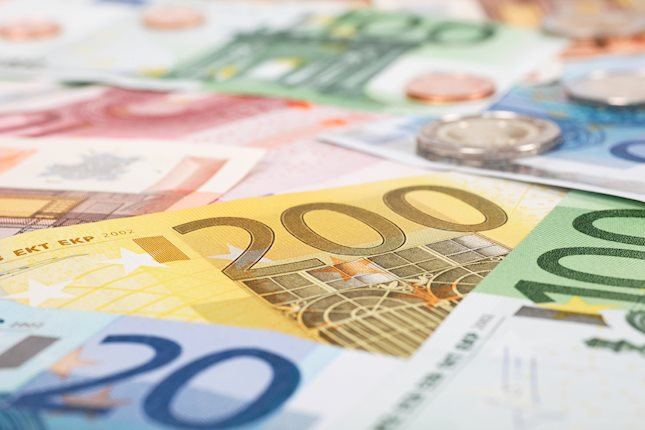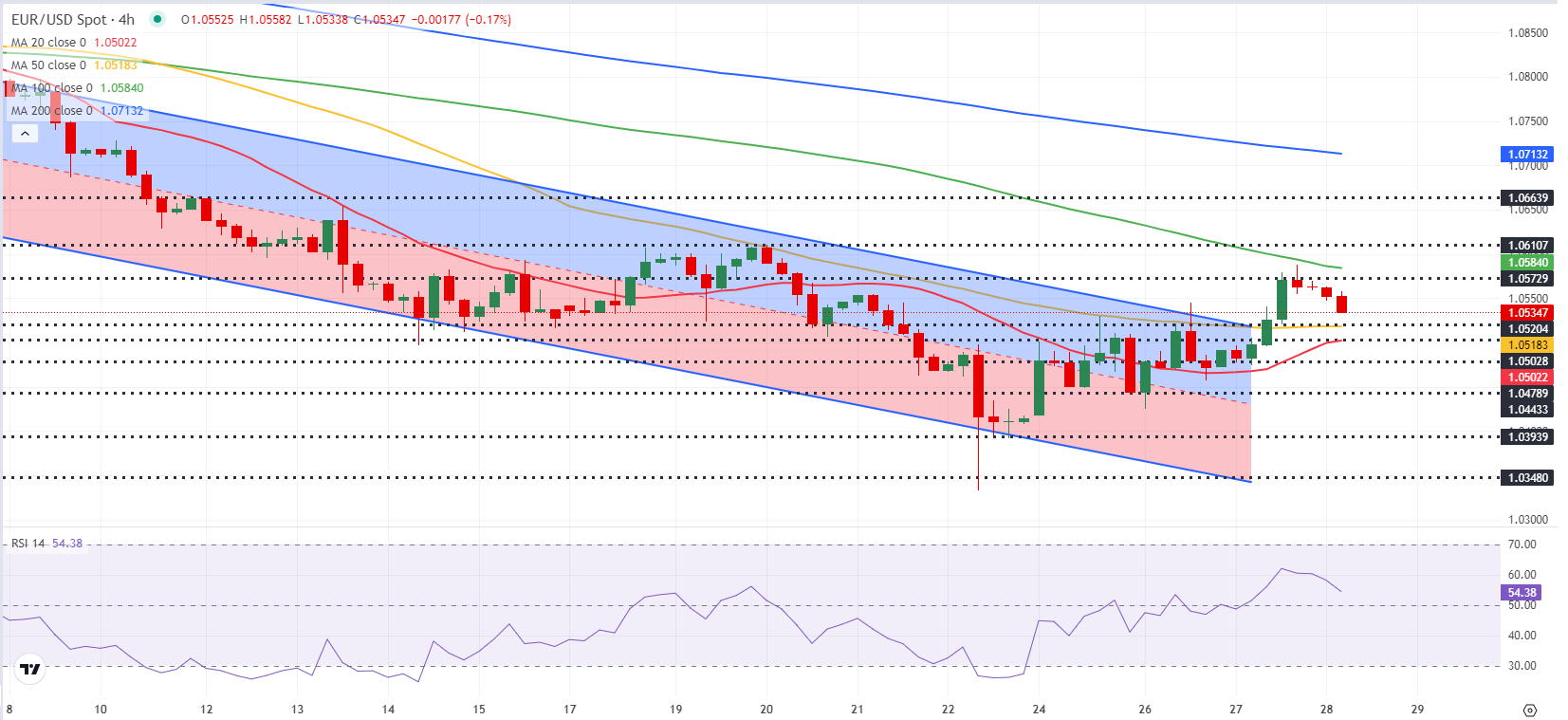- EUR/USD gathered bullish momentum and closed above 1.0550 on Wednesday.
- The pair retreats slightly in the European morning on Thursday.
- Investors await Consumer Price Index data from Germany.
EUR/USD capitalized on the selling pressure surrounding the US Dollar (USD) and registered strong gains on Wednesday. Before reaching 1.0600, however, the pair went into a consolidation phase and was last seen trading near 1.0550.
Euro PRICE This week
The table below shows the percentage change of Euro (EUR) against listed major currencies this week. Euro was the strongest against the Australian Dollar.
| USD | EUR | GBP | JPY | CAD | AUD | NZD | CHF | |
|---|---|---|---|---|---|---|---|---|
| USD | -1.10% | -0.94% | -1.58% | 0.50% | 0.28% | -0.50% | -0.83% | |
| EUR | 1.10% | -0.01% | -1.07% | 1.01% | 1.32% | 0.03% | -0.35% | |
| GBP | 0.94% | 0.00% | -1.07% | 1.02% | 1.33% | 0.04% | -0.34% | |
| JPY | 1.58% | 1.07% | 1.07% | 2.09% | 2.31% | 1.14% | 0.89% | |
| CAD | -0.50% | -1.01% | -1.02% | -2.09% | -0.06% | -0.98% | -1.39% | |
| AUD | -0.28% | -1.32% | -1.33% | -2.31% | 0.06% | -1.28% | -1.64% | |
| NZD | 0.50% | -0.03% | -0.04% | -1.14% | 0.98% | 1.28% | -0.38% | |
| CHF | 0.83% | 0.35% | 0.34% | -0.89% | 1.39% | 1.64% | 0.38% |
The heat map shows percentage changes of major currencies against each other. The base currency is picked from the left column, while the quote currency is picked from the top row. For example, if you pick the Euro from the left column and move along the horizontal line to the US Dollar, the percentage change displayed in the box will represent EUR (base)/USD (quote).
The USD weakened against its rivals midweek following mixed macroeconomic data releases. Moreover, position adjustments heading into the Thanksgiving Day holiday may have played a part in the currency's underperformance.
Durable Goods Orders rose by 0.2% on a monthly basis in October, falling short of the market expectation for an increase of 0.5%. On a positive note, weekly Initial Jobless Claims declined to 213,000 from 215,000 in the previous week. Finally, the Personal Consumption Expenditures (PCE) Price Index, the Federal Reserve's (Fed) preferred gauge of inflation, rose 2.3% on a yearly basis, matching the market consensus, while the annual core PCE inflation edged higher to 2.8% from 2.7%.
Later in the session, regional and nation-wide inflation data from Germany will be watched closely by investors. On a monthly basis, the Consumer Price Index (CPI) in Germany is forecast to decline 0.2% in November. A positive reading could help the Euro gather strength with the immediate reaction.
In an interview with Bloomberg on Wednesday, European Central Bank (ECB) board member Isabel Schnabel said that they could gradually move toward a neutral rate, given the inflation outlook, but warned against moving too far into accommodative territory.
EUR/USD Technical Analysis
EUR/USD broke out of its descending regression channel by rising above 1.0520 on Wednesday and the Relative Strength Index (RSI) climbed above 50, reflecting a bullish tilt in the short-term outlook. In case 1.0520 continues to hold as support, technical buyers could remain interested. In this scenario, 1.0580 (100-period Simple Moving Average (SMA) on the 4-hour chart, could be seen as first resistance before 1.0610 (static level) and 1.0660 (static level).
If EUR/USD returns below 1.0520, it could face interim support at 1.0500 (round level, 20-period SMA) ahead of 1.0440 (static level) and 1.0400 (round level).
Euro FAQs
The Euro is the currency for the 19 European Union countries that belong to the Eurozone. It is the second most heavily traded currency in the world behind the US Dollar. In 2022, it accounted for 31% of all foreign exchange transactions, with an average daily turnover of over $2.2 trillion a day. EUR/USD is the most heavily traded currency pair in the world, accounting for an estimated 30% off all transactions, followed by EUR/JPY (4%), EUR/GBP (3%) and EUR/AUD (2%).
The European Central Bank (ECB) in Frankfurt, Germany, is the reserve bank for the Eurozone. The ECB sets interest rates and manages monetary policy. The ECB’s primary mandate is to maintain price stability, which means either controlling inflation or stimulating growth. Its primary tool is the raising or lowering of interest rates. Relatively high interest rates – or the expectation of higher rates – will usually benefit the Euro and vice versa. The ECB Governing Council makes monetary policy decisions at meetings held eight times a year. Decisions are made by heads of the Eurozone national banks and six permanent members, including the President of the ECB, Christine Lagarde.
Eurozone inflation data, measured by the Harmonized Index of Consumer Prices (HICP), is an important econometric for the Euro. If inflation rises more than expected, especially if above the ECB’s 2% target, it obliges the ECB to raise interest rates to bring it back under control. Relatively high interest rates compared to its counterparts will usually benefit the Euro, as it makes the region more attractive as a place for global investors to park their money.
Data releases gauge the health of the economy and can impact on the Euro. Indicators such as GDP, Manufacturing and Services PMIs, employment, and consumer sentiment surveys can all influence the direction of the single currency. A strong economy is good for the Euro. Not only does it attract more foreign investment but it may encourage the ECB to put up interest rates, which will directly strengthen the Euro. Otherwise, if economic data is weak, the Euro is likely to fall. Economic data for the four largest economies in the euro area (Germany, France, Italy and Spain) are especially significant, as they account for 75% of the Eurozone’s economy.
Another significant data release for the Euro is the Trade Balance. This indicator measures the difference between what a country earns from its exports and what it spends on imports over a given period. If a country produces highly sought after exports then its currency will gain in value purely from the extra demand created from foreign buyers seeking to purchase these goods. Therefore, a positive net Trade Balance strengthens a currency and vice versa for a negative balance.
Information on these pages contains forward-looking statements that involve risks and uncertainties. Markets and instruments profiled on this page are for informational purposes only and should not in any way come across as a recommendation to buy or sell in these assets. You should do your own thorough research before making any investment decisions. FXStreet does not in any way guarantee that this information is free from mistakes, errors, or material misstatements. It also does not guarantee that this information is of a timely nature. Investing in Open Markets involves a great deal of risk, including the loss of all or a portion of your investment, as well as emotional distress. All risks, losses and costs associated with investing, including total loss of principal, are your responsibility. The views and opinions expressed in this article are those of the authors and do not necessarily reflect the official policy or position of FXStreet nor its advertisers. The author will not be held responsible for information that is found at the end of links posted on this page.
If not otherwise explicitly mentioned in the body of the article, at the time of writing, the author has no position in any stock mentioned in this article and no business relationship with any company mentioned. The author has not received compensation for writing this article, other than from FXStreet.
FXStreet and the author do not provide personalized recommendations. The author makes no representations as to the accuracy, completeness, or suitability of this information. FXStreet and the author will not be liable for any errors, omissions or any losses, injuries or damages arising from this information and its display or use. Errors and omissions excepted.
The author and FXStreet are not registered investment advisors and nothing in this article is intended to be investment advice.
Recommended Content
Editors’ Picks

EUR/USD drops below 1.0550 ahead of German inflation data
EUR/USD extends losses below 1.0550 in the European session on Thursday. The pair's downside could be attributed to French political worries and a broad US Dollar rebound amid the cautious mood. Traders remain wary due to mounting trade war risks. Germany's inflation data is in focus.

GBP/USD holds lower ground near 1.2650
GBP/USD remains pressured near 1.2600 in European trading on Thursday as the US Dollar picks up haven dmeand on deteriorating risk sentiment. A sense of cautiom prevails amid Trump's tariff plans even though liquidity remains thin on Thanksgiving Day.

Gold price bulls remain on the sidelines on stronger USD, positive risk tone
Gold price (XAU/USD) reverses an intraday dip to the $2,620 area and trades near the daily high during the first half of the European session on Thursday, albeit it lacks bullish conviction. Investors remain concerned that US President-elect Donald Trump's tariff plans will impact the global economic outlook.

Fantom bulls eye yearly high as BTC rebounds
Fantom (FTM) continued its rally and rallied 8% until Thursday, trading above $1.09 after 43% gains in the previous week. Like FTM, most altcoins have continued the rally as Bitcoin (BTC) recovers from its recent pullback this week.

Eurozone PMI sounds the alarm about growth once more
The composite PMI dropped from 50 to 48.1, once more stressing growth concerns for the eurozone. Hard data has actually come in better than expected recently – so ahead of the December meeting, the ECB has to figure out whether this is the PMI crying wolf or whether it should take this signal seriously. We think it’s the latter.

Best Forex Brokers with Low Spreads
VERIFIED Low spreads are crucial for reducing trading costs. Explore top Forex brokers offering competitive spreads and high leverage. Compare options for EUR/USD, GBP/USD, USD/JPY, and Gold.
